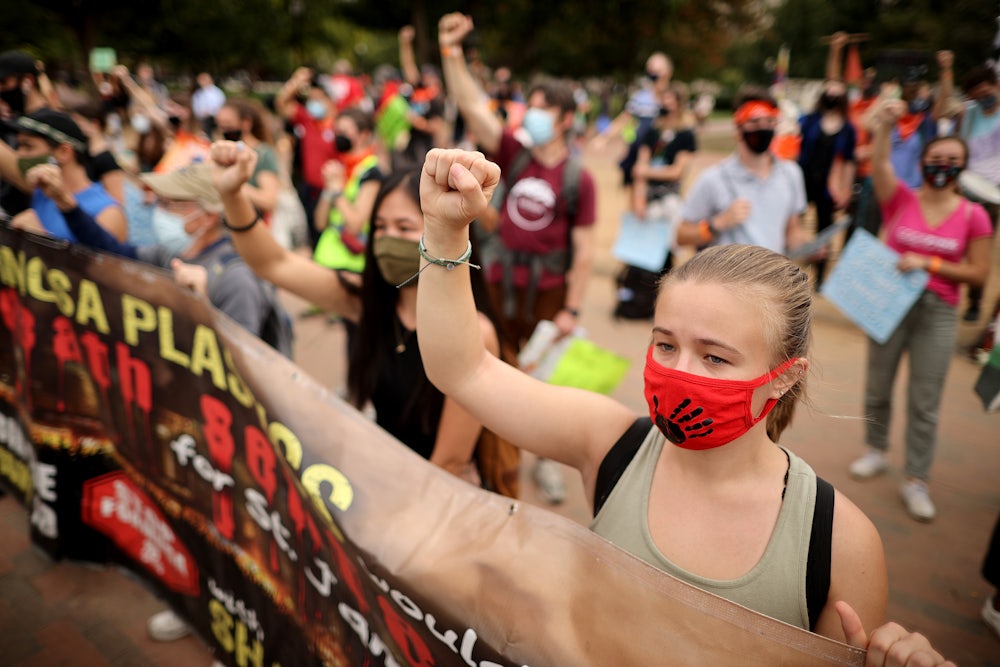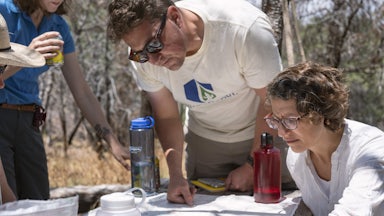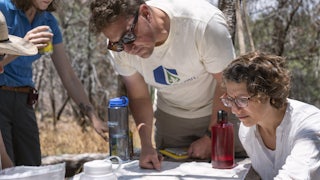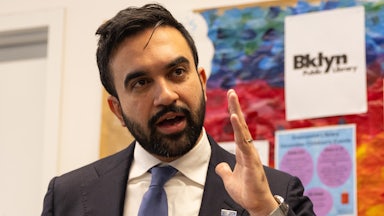For decades, advice for people concerned about climate change has focused on reducing individual emissions. This was not an accident. Since at least the mid-2000s, fossil fuel companies have intentionally tried to shift attention away from their massive contributions to climate change by guilt-tripping individual consumers about their own “carbon footprint”—a term mainstreamed by oil giant BP in 2004.
But as the climate crisis accelerates, more and more people are recognizing voluntary individual behavior changes alone simply cannot stop climate change. Collective action, by contrast, can work. But many people are going to need help figuring out where to start. And while there are plenty of guides for “going green” as a consumer, there’s little advice available for those who want to engage as citizens.
The classic example of collective action, for example, is voting. But it’s increasingly clear that voting is not enough. Sixty-eight percent of Biden voters told pollsters that climate change was very important to their vote—but the Biden administration and Senate Democrats have not been able to deliver any version of a climate package.
The best response to this isn’t to give up on civic engagement—it’s to increase it. Amid the deluge of bad news and deeply uncertain times, there is one certainty: If anything is achieved, it will be because organized groups of citizens demanded it.
To take one example, look at passenger vehicles. Fully electric cars have been widely available to the American public since 2010. Today, fewer than 1 percent of American cars on the road are electric. That’s what voluntary individual action has been able to achieve. To get that number to something like two-thirds of all cars by 2050, as Joe Biden has promised, will require policy change: incentives for people to buy electric cars, tough fuel-efficiency standards for automakers, government investment in charging stations, and more. But these policies will be realized only if people who care about the climate have power. That requires convincing leaders to care and electing leaders who do. Who does this work? Collective action groups on climate.
Many people struggle with the first phase of collective action: picking a group. Some groups are for youth, some for elders. Some are more radical; others are more moderate. Some primarily focus on federal policy, and others work locally. Some mostly are seeking monetary donations, while others want volunteers and money. (Everyone wants money.)
Giving Green, an initiative from the data and research nonprofit IDInsight, is one example of a group that’s now focusing on guiding people to effective actions. The team of “impact evaluation” experts recommends a small handful of organizations in four areas: investments, carbon offsets, U.S. policy, and Australian policy. Within the U.S. policy category, its suggestions include Evergreen Collaborative, a group run by former staffers from Jay Inslee’s climate-centric presidential campaign, and two more politically centrist groups, the Clean Air Task Force and Carbon180. Emily Thai, the manager of Giving Green, describes these as “inside organizations,” which work by shaping legislation and building support for climate policy inside the federal government. They aren’t protesting or campaigning; they are lobbying for legislation, as well as regulation and implementation that can still move forward even though Congress can’t pass Biden’s promised climate package. These groups are likely more interested in dollars than volunteer hours.
For “outside” groups, Giving Green suggests the 15 organizations that comprise the Green New Deal Network—grassroots activist groups organized around the Green New Deal, a set of policy proposals that would aggressively slash U.S. emissions while simultaneously reducing economic inequality. Wen Stephenson, who has covered climate activism as a journalist and engaged personally with the No Coal, No Gas campaign to shut down the last large coal plant in New England, told me that with federal policy seemingly stymied, he’d send anyone who was worried about climate straight for such “outside” groups. The needs of these groups vary but might include phone- or text-banking, door-knocking, organizing protests, creating protest art—along with support tasks like childcare or translation.
These types of groups, Stephenson said, come in many flavors and use a range of tactics, from writing cheerful postcards reminding progressive voters to show up at the polls to physically blocking fossil fuel infrastructure. He tends to favor those that allow for more radical action. “It is hard to think of any successful social movement that hasn’t had radicals: people who are willing to go to the very bleeding edge of what is considered acceptable or reasonable and push really hard,” he told me. He, like many, rejects the idea that people engaging in direct action to fight climate change need to be perfectly green consumers first. “None of us are good enough! The idea that you have to be morally, ethically pure to advocate for a livable climate,” he said, “is a form of ad hominem attack by those who want to discredit the climate movement.”
Stephenson’s top picks are the direct action–focused Climate Disobedience Center and the headline-grabbing Sunrise Movement. Sunrise was founded on the premise that fixing climate change doesn’t need to be economically damaging—that in fact climate policy can also create jobs and further progress toward a more equitable society. Its major public debut was a 2018 sit-in in Nancy Pelosi’s office, calling on mainstream Democrats to treat climate change as the ongoing emergency it is. And many credit Sunrise in particular with helping to shift the Democratic Party toward a more aggressive climate stance in the years since. Sunrise’s steady focus on climate justice and climate jobs has also helped focus the movement as a whole on those issues. John Paul Mejia, a 19-year-old student at American University, in Washington, D.C., and the group’s national spokesperson, describes Sunrise as “a mass movement of young people that have the moral authority to speak about the climate crisis.”
After several years of working primarily at the federal level, Sunrise is now engaging in more local campaigns through its network of local “hubs,” Mejia told me. Sunrise welcomes help from those over 35 but asks them to promise to follow the leadership of the group’s youth organizers and to “keep the space open for the voices of our youth leaders before we share our own,” according to a Sunrise document for older supporters.
There are also organizations now focusing on older activists. Vanessa Arcara and her longtime colleague Bill McKibben, of 350.org, itself a well-respected climate organization, recently launched Third Act, a group specifically for those older than 60. The group sends its tens of thousands of members an action email every month and organizes those who want to do more into groups based on location and skills. Retired educators are working on a “seniors to seniors” campaign to register youth graduating from high school to vote, for example. Arcara said the lopsided intergenerational distribution of resources—Boomers and their elders possess 64 percent of the country’s wealth compared to Zoomers’ and Millennials’ 6 percent—suggests that older people might have a special role to play in any justice movement. “With some degree of comfort comes some degree of responsibility,” Arcara told me.
Identifying and campaigning for a local politician who is enthusiastic about working on climate can also be an effective strategy, especially if the candidate has a realistic chance of winning (but isn’t a shoo-in). Lead Locally specializes in supporting down-ballot climate candidates. Many local climate justice organizations can be found on the membership page of the Climate Justice Alliance, a central location for groups that focus on moving from an “extractive” to a “regenerative” economy and elevating local power. Simply googling “climate justice” and the name of a community isn’t a bad place to start.
It can be easy to get stuck in a research loop, looking for the one perfect group to join. Personally, however, I’ve found that diving in and joining a group that looks appealing is a better bet, since joining any group tends to expose you to others. I found the regional group I volunteer for, Rogue Climate, for instance, when it came to speak at a meeting of a short-lived Indivisible group that I’d joined in 2016.
In the years I’ve worked with Rogue Climate, often no more than a few hours a month, I have made new friends from different generations, learned new skills, and helped stop a proposed fossil fuel pipeline that a giant corporation wanted to run through my county. Sometimes I used my professional skills, writing and editing campaign materials. Other times I helped run a booth at our local Cinco de Mayo festival, or traveled to the state capital to protest. Rogue Climate staff from across the mountains have crashed at my house when visiting for regulatory hearings. In such moments, cooking breakfast and keeping the coffee coming become radical acts of climate protest—as well as sources of joy.
For me, collective action has worked better than therapy to address my anxiety and red-hot anger over climate change. (Then again, activism and therapy could be a powerful combo.) For many, collective action on climate can help address social isolation made worse by years of pandemic. “A big part of our work is about culture and joy and combating this epidemic of loneliness,” Arcara said. “The most effective thing that anyone can do right now as an individual is to start thinking of themselves a little less as an individual.”










